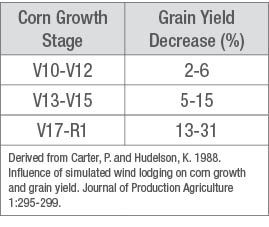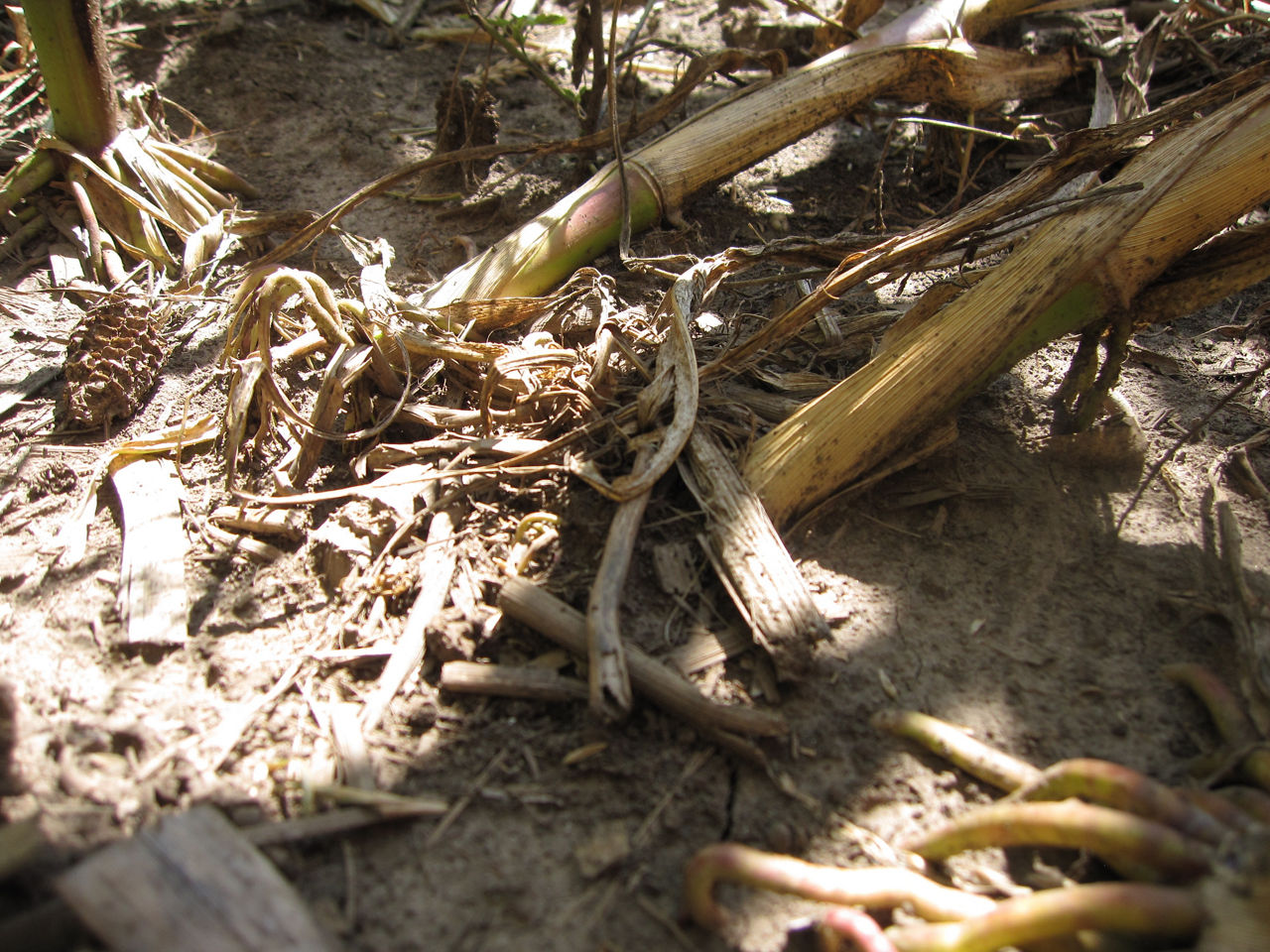7 MIN READ
Root Lodging in Corn
August 29, 2021
Corn root lodging occurs when root growth is unable to anchor the plant against the forces of strong storm winds and abundant rainfall. Factors that can contribute to root lodging include corn product selection, soil and environmental conditions, insect damage, and herbicide injury. Recovery from root lodging depends on the growth stage of the corn plant at the time of the damage. Root-lodged fields should be closely monitored for the severity of lodging and other negative impacts that could require proactive management to minimize yield reductions.
Causes of Root Lodging
Conditions that cause poor root development can predispose corn to root lodging. These include poor soil conditions at planting (wet, cloddy, or compacted soil), shallow planting, corn rootworm pressure, and herbicide injury. Corn root mass reaches its maximum by the R1 (silking) growth stage. Brace roots typically develop starting at the V18 growth stage. Brace roots provide stalk support and can be important in the recovery of plants root-lodged by strong winds. Drought conditions can hinder brace root development and the overall size of the root masses. Excess application of certain growth regulator herbicides can cause up-curling or fusing of the brace roots and twisting of other roots.

Strong winds can pull shallow roots partially out of the soil (Figure 1). Water-saturated soil at the time of a windstorm can make it easier for the roots to be pulled by the force of the wind. Additionally, the stalks can buckle, causing the plant to lodge. Strong winds from one direction may pull the roots on one side of the plant and push roots further into the soil on the other, thus disrupting the “anchoring” system which may result in buckling. A rotation of the downwind root system by as few as 10 degrees is enough to cause buckling of the corn stalk.1 Thunderstorms may also provide powerful downdrafts causing lodging in every direction and corn to flatten in the field.2,3
Effects of Root Lodging
The damaging effects of root lodging on corn can depend on when the damage occurs.4 In general, the younger the corn when damage occurs, the lesser the effect on yield potential (Table 1).3 Corn can compensate for root lodging when the damage occurs before silking (R1 growth stage). Corn stalks are elongating up until the R1 growth stage, and root-lodged plants will bend or “goose-neck” upward with the lower stalk leaning (Figure 2). The younger and shorter the corn, the more it will straighten-up following root lodging without noticeable goose-necking, especially knee-high or shorter corn. The goose-necking will be more pronounced as root lodging occurs to rapidly growing corn in later vegetative growth stages. The lifting or straightening-up of the plant generally occurs within a few days after root lodging without affecting the timing of plant development.


Pollination can still be successful with this type of recovery if both tassel and silked ears are lifted-up by the “goose-necking” of the elongating stalks. If damage occurs at tasseling or within days of pollination, severe yield loss can occur because stalk elongation is essentially completed, and poor pollination could result with tassels and silks close to the ground and possibly covered. If damage occurs after pollination during grain fill, corn plants are unable to straighten up after root lodging and flattening. Corn yield can be affected with late-season root lodging because of reduced photosynthesis and nutrient uptake that could lead to kernel abortion and poor grain fill.
Management Considerations
Depending on the growth stage of the corn crop at the time of a wind event and the severity of wind, corn may or may not return growing upright. It is important to be patient and allow the corn time to recover before estimating damage or potential yield loss.5 Producers should note the growth stage of the corn and if any brace roots had yet formed. Special management should be considered for plants that are damaged but survive. Lodged corn plants that are laying on each other or close to the ground may be exposed to diseases. Fungicides cannot recover yield potential loss due to lodging but may help protect against further yield reductions.
Watch lodged fields closely, especially later near harvest. Goose-necked stalks can be difficult to harvest, resulting in mechanical harvest losses.6 Although yield losses may be minimal, harvesting can be slower with increased potential for ear loss. The use of after-market corn head reels may be of benefit to help direct stalks into the header. Corn stalks and ears laying on the ground from root lodging can be especially difficult to pick up with harvesting equipment (Figure 3). Be patient and figure on a slow harvest with root-lodged corn.

Sources
1Ennos, A., Crook, M., and Grimshaw, C. 1993. The anchorage mechanics of maize, Zea mays. Journal of Experimental Botany 44(1): 147-153.
2Nielsen, R. 2002. Root lodging concerns in corn. Purdue University. www.agry.purdue.edu.
3Lauer, J. 2011. Yield response of flattened (lodged) corn. University of Wisconsin, Integrated Pest and Crop Management. https://ipcm.wisc.edu.
4Nielsen, R. 2011. Prospects of recovery for root-lodged corn. Purdue University. Corny News Network. https://www.agry.purdue.edu.
5Quinn, D. 2021. “Flattened” corn caused by wind damage – now what? Purdue University. The Kernel. https://thekernel.info.
6Elmore, R. 2005. Lodging: mid- to late-season. Iowa State University. Integrated Crop Management. https://crops.extension.iastate.edu.
6001_S8
You may also like...
Here are some articles that may also be of interest to you